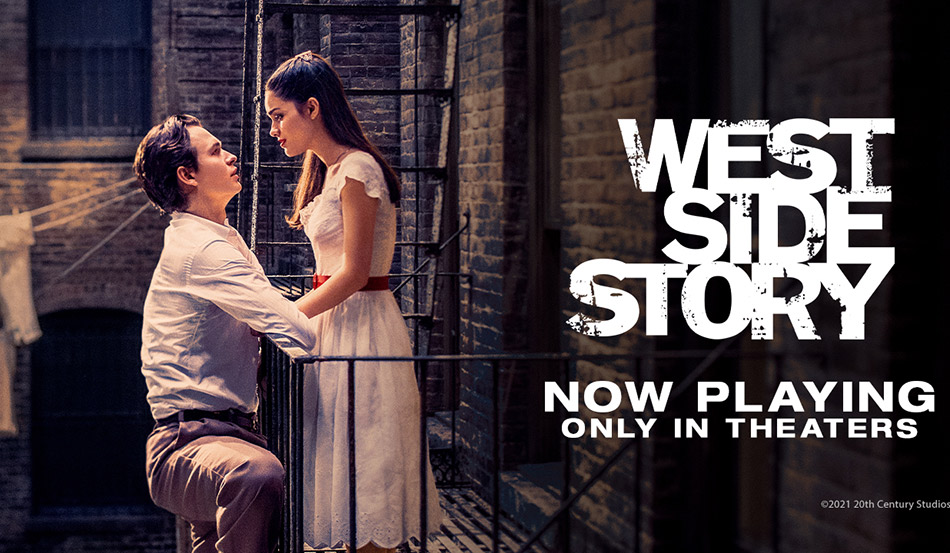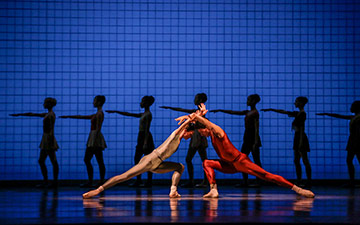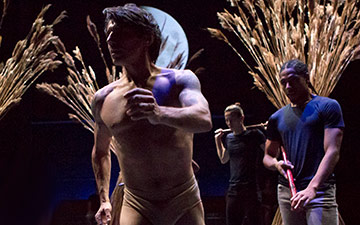
© 20th Century Studios. (Click image for larger version)
General Resource Site: www.westsidestory.com
Steven Spielberg’s 2021 West Side Story
www.20thcenturystudios.com/movies/west-side-story
amblin.com/movie/west-side-story
Jerome Robbins and Robert Wise’s 1961 West Side Story
www.imdb.com/title/tt0055614
When Jerome Robbins conceived, choreographed, and directed the 1957 musical, West Side Story, dance was at the heart of the show, as it was in the 1961 film he co-directed with Robert Wise. Steven Spielberg, in his new take on West Side Story, puts the emphasis elsewhere. For him, dance plays an important but supporting role in a movie that is prose to Robbins’ poetry.
As a whole, Spielberg respects his sources. This begins with the story line, which remains essentially intact: Shakespeare’s Romeo and Juliet transplanted into mid-20th century New York, where two young lovers are caught between warring factions, the Jets and Sharks, street gangs, one white, the other Puerto Rican. However, Spielberg replaces the choreographic nature of Robbins’ productions with dialogue created by Tony Kushner that explains the motivation for action in a kind of detail that held no interest for Robbins and his collaborators. Leonard Bernstein’s score and Stephen Sondheim’s lyrics, created closely with Robbins, also become a support for the narrative in Spielberg’s film, rather than a driving force.
Deborah Jowitt, in her excellent Robbins biography, reports that in correspondence with the 1961 film’s creative team, Robbins insisted it was necessary to find cinematic conventions that would reinforce the unity of elements he had aimed for in West Side Story. Otherwise, he said, they would end up with a straight story-telling movie. Wise seems to have agreed, since the film walks a fine line between aspects of realism, such as street scenes filmed on location, and expressive elements, conveyed through music, dance, and cinematography.
In the Spielberg film, Kushner’s new book explains plot details and larger issues left unspoken in the earlier film. In the 1950s, a perceived rise in juvenile crime loomed large, echoing a post-war youth culture of rebellion, reflected in numerous sociological studies, as well as in films like Blackboard Jungle and Rebel Without a Cause. Robbins’ West Side Story addressed this concern which, to many, threatened to tear society apart, while viewing issues of race and immigration as part of the problem.
Today, it is immigration and racial injustice that dominate the news, and Spielberg and Kushner push these themes to the center of their project. A printed signboard proclaiming “Slum Clearance,” appears early on, while another sign shows an image of the new Lincoln Center for the performing Arts, which will replace the gangs’ neighborhood. Lieutenant Schrank, a corrupt police officer, temporarily corners both gangs, then sneers that they are all losers. The winners, he tells them, will be the real estate developers and the rich, who will take up residence in the luxury buildings soon to rise on the ruins of the old, and where the only Puerto Ricans will be doormen. To emphasize the point, Spielberg sets the action amidst the area’s demolition, an opening pan prominently displaying a wrecking ball.
As for dance, whenever possible Spielberg attempts to make it grow out of the storyline rather than using it as a metaphor for the characters’ deepest emotions. This is easy enough to do with the dance at the gym, where the gangs compete on the dance floor. But Spielberg doesn’t leave it there. Tony and Maria, the Romeo and Juliet counterparts, meet and discuss whether or not he likes dancing, before swaying into movement. “America,” another important dance number, which in the Robbins film takes place on an apartment house roof, here starts on a fire escape before moving out to become a street party.
In the opening scene of both the Robbins and Spielberg movies, the gangs meet on a playground and end in a fight that prefaces the tragedy to come. Both films start with eerie warning whistles, but in Robbins’, we then hear a rhythmic snapping of fingers from the Jets who are lounging at the edge of a playground. The snapping signifies boredom, waiting, looking for trouble, threat. It also sets up the choreographed nature of the scene, which moves from everyday walking into slides, reaches, crouches, and high jumps that convey the gang’s energy and aggression. After the rivals meet, a series of choreographed chases ensue, which ends in a melee, stopped by the police. As sirens are heard, the dance quality is maintained, as one boy after another looks up in time to the musical rhythm, before escaping.
Spielberg’s version of this scene includes dance, but its impact is mitigated by being depicted as a prelude to painting out a Shark’s wall mural. The Jets toss paint cans to each other in preparation for the attack. When the Sharks appear to defend their handiwork, the scene is dominated by battling amid wet paint, and interjections, like the release of watermelons from a passing cart, which slows the rival gang’s pursuit. Other scenes, such as the rumble, which Robbins visualized as choreographed, are also given more straight action treatment.
Justin Peck, who created the choreography for Spielberg, seems to have been more a hired hand than a central player, his role vastly different from Robbins’. Although Peck is resident choreographer at New York City Ballet and recognized in his own right, he may have been particularly attractive to Spielberg because he worked with Robbins when both were at City Ballet. Whatever the motivation, Peck’s dances owe much to Robbins, making little attempt to break new ground or put his own stamp on the choreography.
Despite Spielberg’s shift in emphasis, it is clear that dance was still an important factor for him because he chose first rate dancers for the central roles of Riff (Mike Faist), leader of the Jets, Bernardo (David Alvarez), leader of the Sharks, and Anita (Ariana DeBose), Bernardo’s girlfriend. And when they dance they are as impressive as the earlier cast of Russ Tamblyn, George Chakiris and Rita Moreno (who returns for a non-dancing role in the new film). Robbins initially intended Tony and Maria to dance a dream ballet near the end of the musical, in which they imagine a peaceful community that turns to the nightmare of reality. However, the dance was dropped before the show opened and Maria and Tony became primarily acting and singing roles, as they do in Spielberg’s film
In their quest for a unity of elements, Robbins and Wise used other non-verbal elements, in addition to choreography, to convey emotion and to stress the fact that West Side Story was more than narrative with music and dance attached. These included the use of color. Where Spielberg might offer a sunset, Robbins and Wise suffused the screen with blood reds that engulf entire neighborhoods, or that, splashed on a wall, mirror a character’s rage. Or they eliminated color, as in the aerial views of Manhattan that begins the film, swooping over buildings and streets reduced to a uniform sepia, the only exception a flash of green from an isolated park.
They also used other effects to emphasize the poetic nature of the film. When Tony and Maria meet at the dance in the gym, all the figures around them become whirling shadows; the two see only each other. Spielberg has the lovers notice one another across the crowded gym and then meet beneath a set of bleachers. Spielberg shows us how things actually happen; the earlier film, how they feel. This is not to say Spielberg’s West Side Story is unsuccessful. It offers a compelling account of contemporary problems while giving the original plot added detail. Spielberg brings West Side Story down to earth. Robbins and Wise, on the other hand, created magic.

















I’d certainly agree that the new Spielberg version is an altogether harder-edged story than we see in the 1961 original, and that Dance is less central to its telling. However, Ms Morris makes a good point in mentioning that the actors/dancers used seem very much the equal of their 1960s colleagues. Are the new voices better? Perhaps they are, but it’s a close call. Overall, we’ve had varying visions of all sort of stories down the years and, 60 years on from the Robbins version, there’s room for this new one.
PS: Having Rita Moreno as Doc’s widow singing “Somewhere’ was a masterstroke.